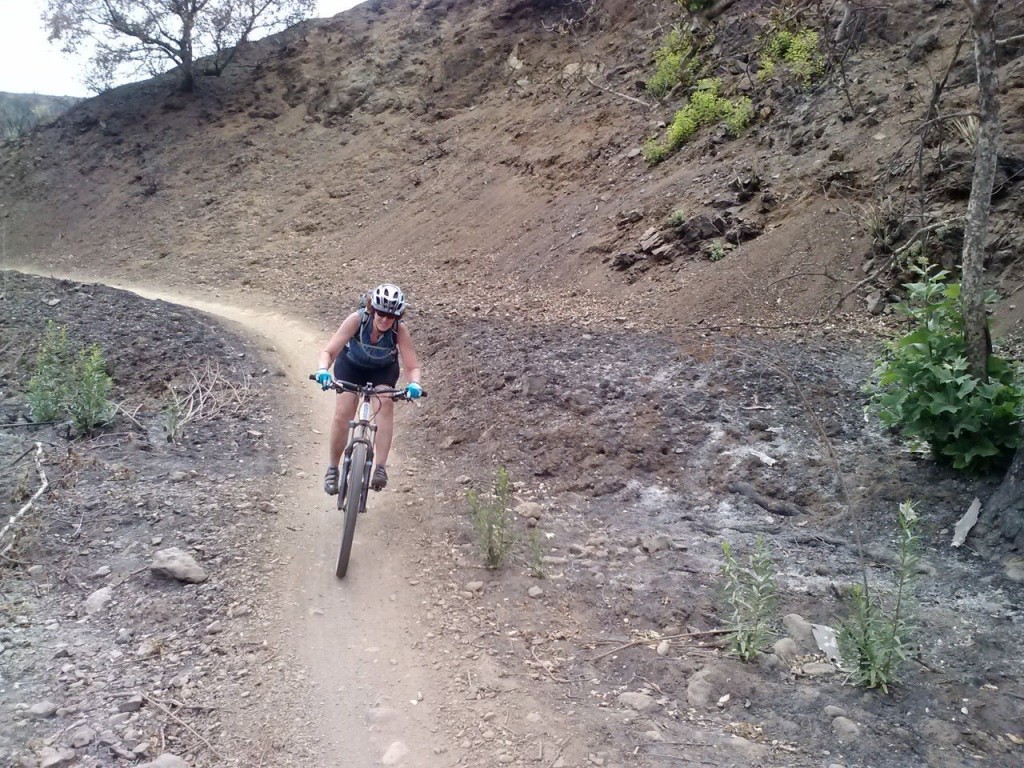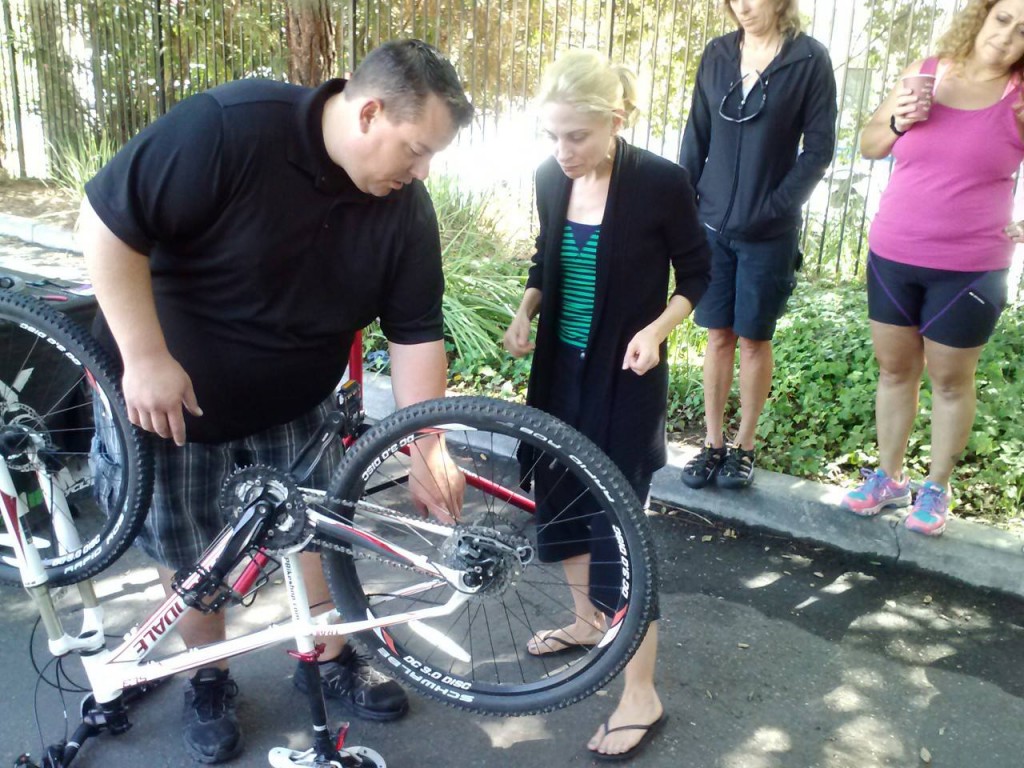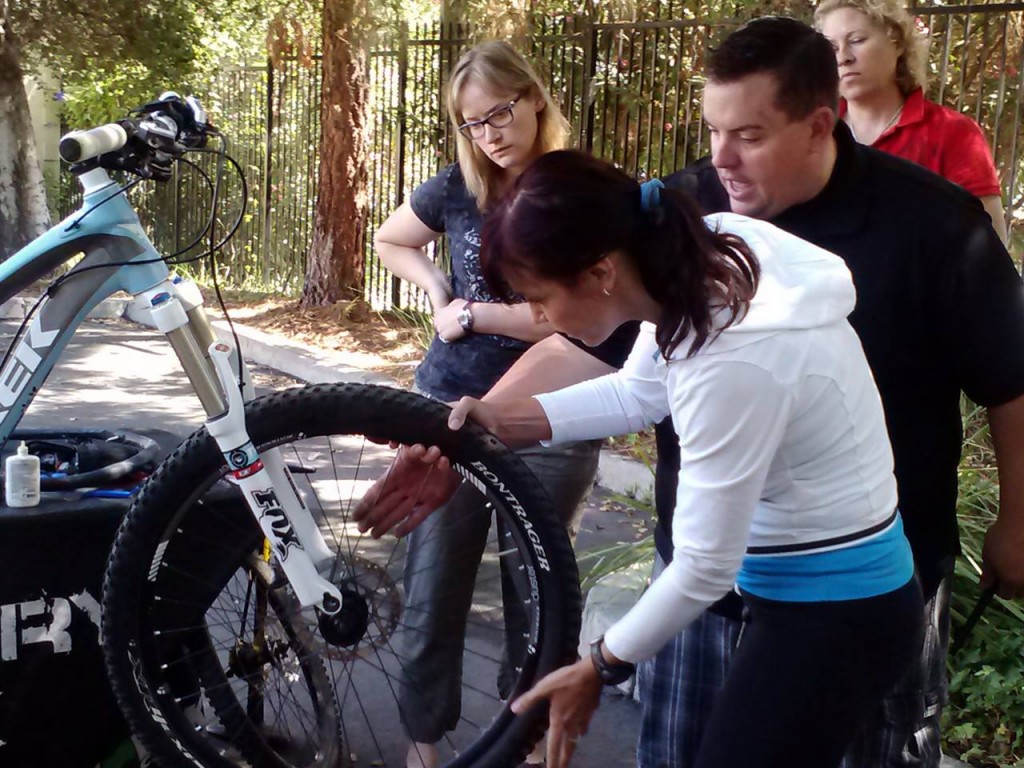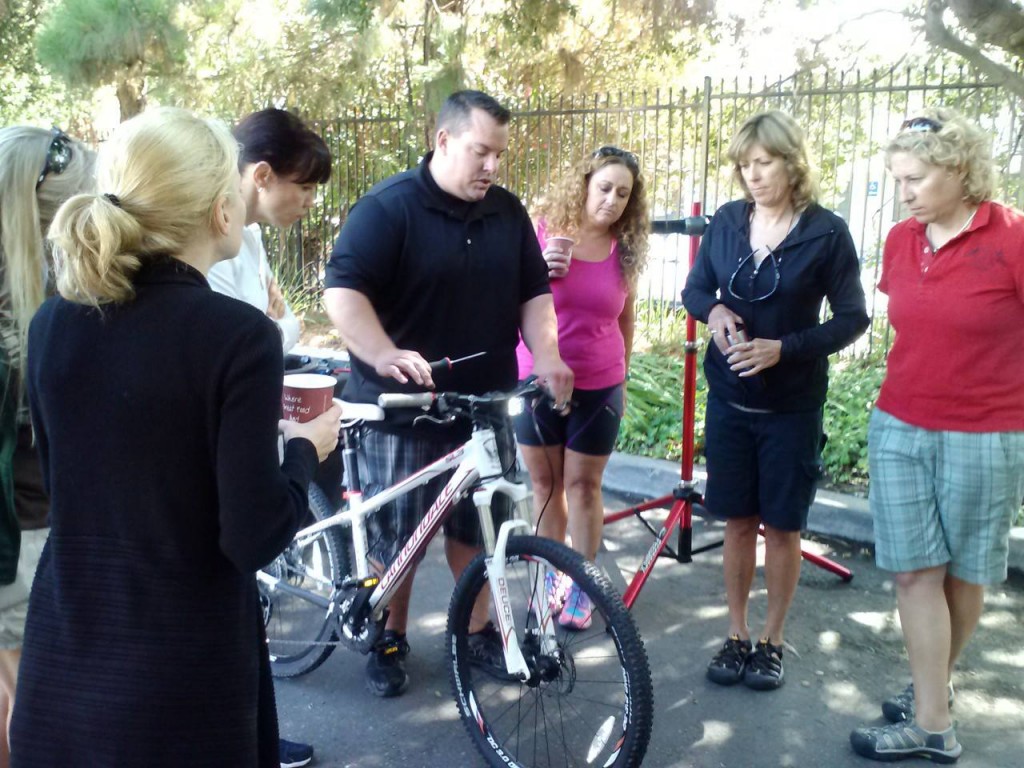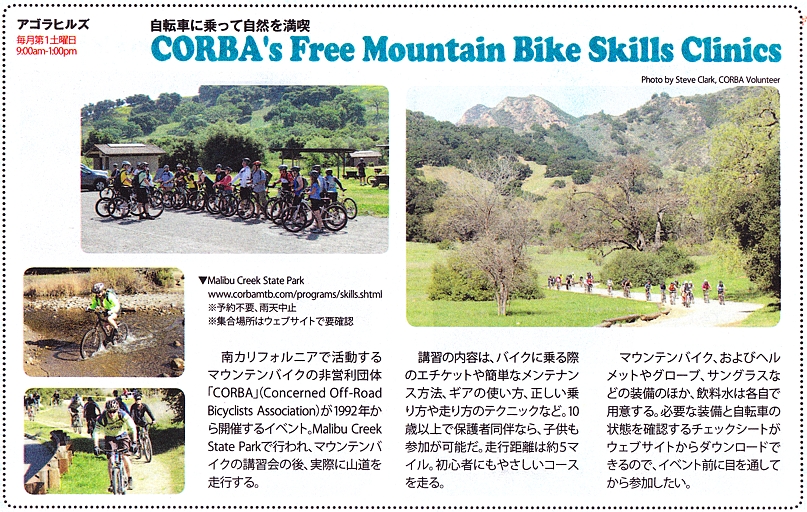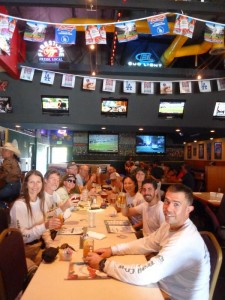About two weeks ago, Michelle of the North Ranch Mountain Bikers led a combined North Ranch and CORBA beginners ride in Pt Mugu State Park, starting in Newbury Park and riding to the PCH, and then back. I made video recordings of much of the ride, and have put together an 8-minute video so that others can see what our beginners rides are like. Also, you can see how the area is already recoving from the Springs Fire that decimated the area in early May.
Archive for the ‘Santa Monica Mountains’ Category
Beginners Ride Video in Pt Mugu State Park
Sunday, August 18th, 2013CORBA’s Comments on State Parks’ Rulemaking Process
Thursday, August 15th, 2013 Last year, a disconcerting fact came to light. The California Public Resources Code, under which State Parks operate, contained a rule that essentially allowed bicycles on State Parks trails unless specifically closed to them. It also contained a rule that trails were closed to equestrians unless specifically opened to them.
Last year, a disconcerting fact came to light. The California Public Resources Code, under which State Parks operate, contained a rule that essentially allowed bicycles on State Parks trails unless specifically closed to them. It also contained a rule that trails were closed to equestrians unless specifically opened to them.
State Parks’ practice and policy for these past 25 years has been the exact opposite.
While considerable progress has been made by State Parks in acknowledging the legitimacy of bicycle use in State Parks at the policy level, in practice little has changed. CORBA has fought long and hard to gain more equitable access to trails in State Parks, and in fact, virtually all of the singletrack trails in the Santa Monica Mountains that are open to bicycles, are open either directly or indirectly, because of CORBA’s efforts.
Yet there is a rule currently on the books that, if followed, would have helped give us access to trails two decades ago.
State Parks held two private focus group meetings in October 2012, at which both CORBA and IMBA were represented, along with equestrians, hikers, and environmentalists. Those focus groups almost unanimously called for more inclusive rules that allowed both equestrians and cyclists access to trails unless specifically closed to them, despite the policy and practice in place.
Also discussed were rules regarding “minimum tool use” with the goal of only allowing use of only the minimum tools required to complete a task, in State Preserves (natural and cultural).
Fast forward nine months, and the proposed draft rules were released and public meetings were scheduled. One of the public meetings was scheduled AFTER the public comment period closed. The draft rules were the exact opposite of the consensus of the focus group meetings in which we participated.
We understand that due to the seriously flawed nature of this public rulemaking process, and the confusion resulting from these poorly drafted rules, that there will be another chance to comment on them. Details of the current drafts are available at http://www.parks.ca.gov/?page_id=27460
While this was not an issue that required a show of numbers by the public, even the limited public process involving stakeholder groups such as CORBA and IMBA was flawed. Our comments follow, and we’ll keep you informed when there are any further developments in the process.
————————————————————-
August 15, 2013
Alexandra Stehl, Statewide Trails Program Manager California Department of Parks and Recreation PO Box, 942896 Sacramento, CA 94296 Alexandra.Stehl@parks.ca.gov
Re: State Parks Proposed Rule Making Comments
Dear Ms. Stehl,
I am submitting these comments on behalf of the Concerned Off-Road Bicyclists Association (CORBA), a chapter of the International Mountain Bicycling Association (IMBA). We are a 501(c)(3) non-profit representing off-road cyclists in the Los Angeles and Ventura County region. We have been working closely with State Parks on trail-related issues since our founding in 1987. Our volunteer trail crews have contributed many thousands of hours of labor to trail maintenance efforts in State Parks. We serve as a bridge between land managers and the mountain biking community, educating and encouraging trail users on proper trail etiquette and responsible trail use, while at the same time advocating for protection of public lands and equitable access to the trails by which the public enjoys those resources for all trail users.
Having participated in the initial invitation-only focus group meetings conducted by Charlie Willard, we were initially dismayed to learn that State Parks policy of trails being “closed to bicycles unless specifically opened“ had been implemented in direct contradiction to the language of Title 14, division 3 of the Natural Resources Code. The policy of equestrians being permitted on trails unless specifically closed to them was also in direct contradiction to the code. We welcomed the opportunity to be a part of the process of rectifying this situation. The outcome of those focus group meetings appeared to be overwhelmingly in support of language that welcomes and includes equestrians, hikers and cyclists as trail users on State Parks trails. The proposed draft rules fail to meet that goal shared by the focus groups in both Southern California and Northern California, and appears to have completely ignored our input.
We therefore fully support and agree with the position taken by IMBA. We encourage State Parks to adopt the language submitted by IMBA for Title 14, Division 3 of the Natural Resources Code as follows:
§ 4360 – Trail Use
State park trails are open to non-motorized users including hikers, bicyclists, and equestrians unless otherwise designated. Trail use designations are established based upon user needs, visitor safety and environmental sustainability. This includes access to trails in Reserves and Preserves, as defined in PRC Sections 5019.65, 5019.71 and 5019.74, where particular emphasis will be placed upon importance of public access to the area, or desirability of providing important connections to other trails, provided impacts to special resources for which the area was established will be less than significant.
We put forward this language to replace existing provisions in the Natural Resources Code (§4359 and §4360). It will also include the provisions of proposed §4360.1, which we, and IMBA, urge be eliminated.
IMBA’s and others’ comments also include a background of State Parks policy and the policy’s contradiction to the existing code. CORBA has been at the forefront of these issues and we have played an ongoing part in that history and background. Despite more than two decades of gradual State Park policy changes to be more inclusive of cyclists, the rate of actual progress towards increasing trail access and opportunities for cyclists has been painstakingly slow and frustrating. This is an opportunity for State Parks to follow through on their stated goals of providing increased access for bicycles. The language proposed by State Parks would be a step backwards in this process.
There are many reasons for adoption of the above language, or even to retain the existing language of §4360, and change §4359 to include similar language to that for bicycles in §4360, allowing equestrian access to trails unless specifically closed to them. As a group we advocate for shared-use trails, and feel that the message sent by the proposed exclusionary and negative language sends the wrong message to State Park unit superintendents and managers, and sets the wrong example for other land management agencies who may be influenced by State Park rules and policy.
It also sends the wrong message to the public. The proposed language has the potential to further and compound perceived user conflict by giving one user group a sense of “superiority” over other user groups; it legitimizes and reinforces this perceived conflict, and discourages the sharing of multi-use trails. As outlined in the State Parks Trail Change In Use PEIR, Appendix A, even perceived conflict is rare, and actual incidents are rarer still. The language we are proposing will help promote a sense of community, sharing of trails, and is in line with State Parks’ stated goals of providing more trail opportunities to off-road cyclists.
Management practices exist to close specific trails to particular user groups where legitimate, objectively-determined concerns or environmental impacts are demonstrated. Therefore, adopting this more welcoming language will not have any immediate impact on existing trails, and where impacts are demonstrated, the means to close them is already in place. This should place no additional burden on State Parks, above that of the now-adopted Change-In-Use process. Further, a more uniform shared-use policy will be easier to manage and police than the current status quo.
Our proposed language is also in keeping with current research on trail and resource impacts by different “muscle-powered” user groups. It treats each user group equally, just as overall impacts to resources and trails by each of the major muscle-powered user groups have been demonstrated to be similar. It is now well-understood that the greatest impacts to trail and resource sustainability are the result of poor trail design, rather than any particular user group. The proposed language appears to ignore this fact.
With regards to the proposed changes to the “Minimal Tool Use” sections of Division 3 of Title 14, we are deeply troubled by the proposed lumping together of Preserves and State Wilderness. These are two distinct land-use designations (actually three if you include ‘cultural’; and ‘natural’ preserves) that require distinct, but at times overlapping, approaches to management. The term “mechanical transport” as it applies to State Wilderness is NOT applicable to Preserves as proposed. The unintended consequences could be daunting, with significant impacts to cyclists and the mobility-impaired as user groups. While the concept and goal of “minimum tool use” is appropriate for both natural preserves and state wilderness, the proposed language can too easily be misinterpreted. We have been informed that State Parks does not wish to summarily exclude cyclists from Preserves, yet the proposed language does just that. We urge State Parks to either retain the existing sections §4351 and §4351.1, or to prepare language that avoids misinterpretation and unintended consequences.
Given the haphazardly drafted proposed rules, and numerous problems with the process–including scheduling public meetings AFTER the public comment period closes–we can only surmise that the draft rules were preordained prior to any public process and were put together with complete disregard to public input. The public and private meetings seem to have been held only to placate the public, not to seek actual input. We therefore urge State Parks to continue the public process appropriately and professionally, and allow for another round of public comments on the revisions that come out of this comment period.
Thank you for consideration of our comments. If you have any questions, feel free to contact us.
August Skills Clinic photos published
Saturday, August 3rd, 2013The photos from the August 3rd Skills Clinic at Malibu Creek State Park have just been posted on this website. Thre were 29 riders today on a lovely day for riding. You can see them in the August 2013 photo gallery.
I’d Like to Thank…
Tuesday, July 30th, 2013By Mark Langton
When I learned that CORBA would be inducted into the Mountain Bike Hall of Fame, my first reaction was, “where do we begin to start thanking people?” If you go back to the inception of CORBA, it all started with a 1987 Santa Monica Mountains Conservancy (SMMC) meeting where one of the agenda items was to consider adopting California State Parks’ policy of single track trails being closed to bicycles. So I guess you could say that CORBA owes a debt of gratitude to the SMMC for considering closing trails to bikes.
There were quite a few mountain bikers at that SMMC meeting, myself included. We sat patiently while the committee members discussed the pros and cons of allowing this “new” recreation on their public trails. They decided to adopt the State Parks policy, but they would continue dialogue with “the bike group” to see if bicycles could be integrated into the trail system. The cyclists in the audience looked around and silently acknowledged that “I guess we’re the bike group.” A legal pad was passed around and the list of people collected at that meeting became the impetus for CORBA. (Since then SMMC has adopted an inclusive policy toward mountain bikes.)
Twenty-six years later, we are still having to address issues of whether or not bicycles can coexist on public open space trails, mostly on State Parks’ trails. It’s like when snowboarding became popular at ski resorts. There was a lot of animosity leveled at snowboarders by skiers. A partial solution was to create separate areas where snowboarders could do their thing and skiers knew to stay away from those areas. But with public open space trails, we don’t necessarily have that luxury. If we want to share the trails, we have to behave accordingly and expect that there may be hikers, equestrians, and other (less experienced) cyclists on those trails.
The sport of mountain biking is evolving much like the sport of skiing has evolved to include snowboard riders. Separate areas are being developed to accommodate “gravity” mountain biking, and CORBA is working with land managers in our region to develop mountain bike parks that allow for more aggressive riding, including jumps, drops, and technical features. We will be announcing some very exciting news within the next few months regarding these new areas!
If you want something to last, you have to be willing to commit to the long haul. I’m not sure if that’s what the founders of CORBA set out to do, but thanks to them and everyone who got involved from then until now, we have a lasting legacy and solid foundation that will serve the next generation of mountain bikers in the greater Los Angeles and Eastern Ventura Counties.
And when we accept the award on behalf of CORBA for being inducted into the Mountain Bike Hall of Fame, you can be sure that everyone on that stage will be feeling the pride of all of those who have supported CORBA over the last 26 years.
GirlzGoneRiding News for August
Tuesday, July 30th, 2013From Wendy Engelberg
On Sunday we had 16 awesome GGR girlz participating in the Wenches with Wrenches workshop at Newbury Park Bike Shop. http://www.npbikeshop.com/. These clinics are limited to typically only 15 GGR members,
Dorothy Twitchell, the events director of NPBS greeted us with our own clinic space, a valet for our bikes and breakfast goodies!
Shane, the GM held the clinic while Dorothy and Ben were there to help in any way they could. The clinic’s focus was to simulate things that can happen on the trail and repair them enough so we don’t have to walk our bikes out of the trail.
The clinic started out with a pre ride check list that was very thorough and led us to MANY other things. We discussed the most important things to put in our packs, how to repair a broken chain, re thread the chain, what to do when a spoke brakes, rim is bent, suspension set up and more.
For those who wanted more, there was a separate clinic for pulling out and changing your brake pads and even repairing flats.
GGR would like to sincerely thank Newbury Park Bike Shop for spending your Sunday with us, holding an outstanding, very, very useful workshop and really getting involved in our local women’s cycling community. Other bike shops………step up! YOUR TURN!
GGR girlz Wendy, Lisa, Karine, Dianna, Mila and Jennifer went for a ride in Sycamore Canyon after the clinic. This was the 1st time I have ridden there since the fires. This was also a few of the girlz longest rides ever at a respective 18 miles which is a big ride for these newbies! Well done ladies! You rocked it!
Until next time girlz…..GGR girl Wendy
July Skills Clinic photos published
Wednesday, July 10th, 2013The photos from the July 6th Skills Clinic at Malibu Creek State Park have just been posted on this website. Mark was on his own this month because both Ezra (Mark’s regular assistant and MBU volunteer) and Steve (normally reliable photographer) were out of town, so in addition to his normal teaching duties, Mark took photos when he could. It looks like there was quite a large class, about 30-35 participants, based on the first photo. You can see them all in the July 2013 photo gallery.
Long Time Trail Advocate Linda Palmer Has Died
Monday, July 1st, 2013Linda Palmer, a long time advocate for preservation and construction of trails in the Santa Monica Mountains, has died. Linda was a past president of the Santa Monica Mountains Trails Council and served for many years on the Advisory Committee of the Santa Monica Mountains Conservancy. If you ride or hike a trail in the Santa Monica Mountains National Recreation Area, you owe a debt of gratitude to Linda. We send our condolences to her family and friends.
CORBA’s Skills Clinic article for Japanese
Sunday, June 30th, 2013Los Angeles’ Japanese language periodical “Lighthouse” has written up a short article on CORBA free basic Skills Clinic, held every month on the first Saturday at Malibu Creek State Park.
The following translation was provided by Miyuki Tanaka:
Enjoy nature on your bike – CORBA’s Free Mountain Bike Skills Clinic
Agoura Hills – First Saturday every month
*No reservation required, cancels with rain
*Please check the meeting location on the website
‘CORBA’ (Concerned Off-Road Bicyclists Association), the non-profit organization for mountain biking in Southern CA, has held the events since 1992. The clinic is held at Malibu Creek State Park. After the clinic, you will ride the actual trail.In the skills clinic, you will learn the manner on the trail, basic bike maintenance, gear shifting, riding form and technics and more. The clinic is available for individuals from 10 years and up (with adult supervision for kids). The ride is about five miles and the course is easy for beginners.
You need to bring your mountain bike, helmet, gloves, sunglasses and water. You can download the check list for the gears you need from the website.”
June 15 Guadalasca Trailwork Report and Photo Gallery
Monday, June 17th, 2013This past Saturday, about 30 volunteers from CORBA, North Ranch Mountain Bikers, Girls Gone Riding, DirtChix, the Santa Monica Mountains Trails Council, the Ventura County Trail Runners and others came together at the top of the Guadalasca singletrack in Pt Mugu State Park to groom the trail after it had been levelled by a small bulldozer, fondly known as a Sweco.
As explained in our previous blog, State Parks has wanted for some time to fix the huge ruts and drainage problems on Guadalasca. The recent Springs Fire provided added incentive and also opportunity. Incentive came because unless something was done, rainwater would race down the denuded hillsides, carrying ash and mud with it, run onto the trails and then down it, futher erroding the already deep ruts, and also clogging it with crud. Opportunity came from the lack of brush along the trail edge, and overgrowing it, that normally impedes treadwork, and by the eagerness of volunteers to pitch in to help repair the trail and protect it from long-term damage as a result of the fire. On Wednesday and Thursday of last week, Dale Skinner, hands-on head of trail maintenance for State Parks in the Santa Monica Mountains, used the Sweco to push down the berm (the hump on the outside edge of the trail that keeps water from running off) and fill in the huge rut. He also pushed large rocks off the trail.
The Sweco leaves the trail generally level, but very loose and rough. Also there are a number of rocks of various sizes mixed in with the loose dirt. To finish the trail, any remaining berm must be removed, rocks larger than walnuts are swept off the trail, and the surface is sloped outwards so water will run across it and off, rather than down it. On Saturday, the volunteers along with Dale and two other State Parks staff, carpooled and caravanned to the top of Hell Hill, then hiked the 1.3 miles to the top of the singletrack section where work would begin.
We broke into four groups, each of which occupied about 20-30′ of the trail. The leading group fixed the biggest problems, the last group made sure the trail was in as good condition as it could be, and the two intervening groups sequentially improved the trail as they went. Every 10-15 minutes, the groups shifted down so that each one was working where the group in front of it had been, and the leading group had fresh trail to address.
The result was basically an assembly line of trail improvement, with raw Sweco’d trail and the start, and smooth, flat and fairly well packed trail at the end.
When we got to a switchback, some of the workers broke off and helped build a stone wall to fortify it, and may have built special drainages to keep the water from running around it and down the trail.
We were scheduled to be back at the cars by 3:00 pm, which meant we needed to finish work on the trail by about 1:30 so we would have time to get back. Dale had Sweco’d about 0.7 miles of the singletrack, but by 1:15 we still had a couple hundred feet to finish. We didn’t have time for that, so instead we pulled down as much berm as possible so rainwater would be able to get off the trail. (We don’t know when we’ll get a chance to work on this trail again other than it won’t be until the fall at the earliest.)
The trail was amazingly improved after we had been down it, compared to how the Sweco left it, but still it was somewhat loose. Fortunately, the nature of the dirt there is that it packs down very quickly and the couple dozen mountain bikers who rode by as we were working helped a lot to pack it down. The next day it was packed well enough that a good biker could ride up it without much difficulty, so it should only take a couple of weekends of riders to pack it down to about 90% of normal.
After we got back to the cars, CORBA had their customary gift give-away to show appreciation to the volunteers who donated their time to help fix the trail, and then about a dozen of us headed to Magoos in Newbury Park for CORBA’s thank-you lunch.
You can view the trail crew at work and thank-you activities afterwards in our Guadalasca trailwork photo gallery.
There is no question that all the volunteers had a good time working on the trails and recognized that it was in much better shape when we left it than before the Sweco went down it. For many volunteers, this was the first time they had done any trailwork, and they were surprised by how much fun it was and how much the group accomplished, and were delighted to have the chance to give back to the trails they use every week.
CORBA and the other groups would like to extend a super “Thank-You” to the volunteers who came out to help – you deserve a great big pat on the back!
Guadalasca rejuvenation started on June 12th
Friday, June 14th, 2013On Wednesday, California State Parks staff started the rejuvenation process of Guadalasca Trail in Pt Mugu State Park (Sycamore Canyon). They’re running a Sweco (mini bulldozer) down the trail, pulling down the berm on the outside and filling in the huge rut that runs almost the length of the trail.This is part of a process that was started in late 2011 and CORBA has been helping with over various trailwork days.
State Parks will be running the Sweco down to the point where it is to be eventually rerouted, just below the second lowest switchback, about 1.1 miles from the top of the singletrack section.
On Saturday, the 30 people or so who have signed up for trailwork will be knocking down any loose berm left behind, removing rocks and filling in any big holes.
I rode from the top down to where the work had progressed at the time, about 200 yards or so. The trail is currently pretty rough and somewhat loose. If you’re looking for a really good workout, try riding up this trail once the work is complete!
The loose rough conditions are temporary. Slowly the trail will be packed down as people ride it (mostly downhill, I expect) and eventually it will be in great shape. Some people will be upset at it’s current state, but this trail really needs the ruts fixed, and when it recovers, it will be much more fun to ride than it is now. In some places the rut is so deep I can’t ride in it without banging my pedals on the side. The result is that people ride up the edges, widening the trail on both sides. That may be easy to do now, but it makes for a really wide and ugly scar on the hillside, and the trail edges won’t be viable for riding once the vegetation that was removed by the Springs Fire a month ago grows back.
Wood Canyon Vista Trail (Backbone) was Sweco’d two years ago and has been in really good shape for over a year now, and is in fantastic shape now, especially after the trailwork we did there last week.
But be warned, unless you want an extreme challenge, I suggest you avoid trying to climb Guadalasca until it’s been packed down a bit. Even riding down it will be more challenge than some people will welcome!


